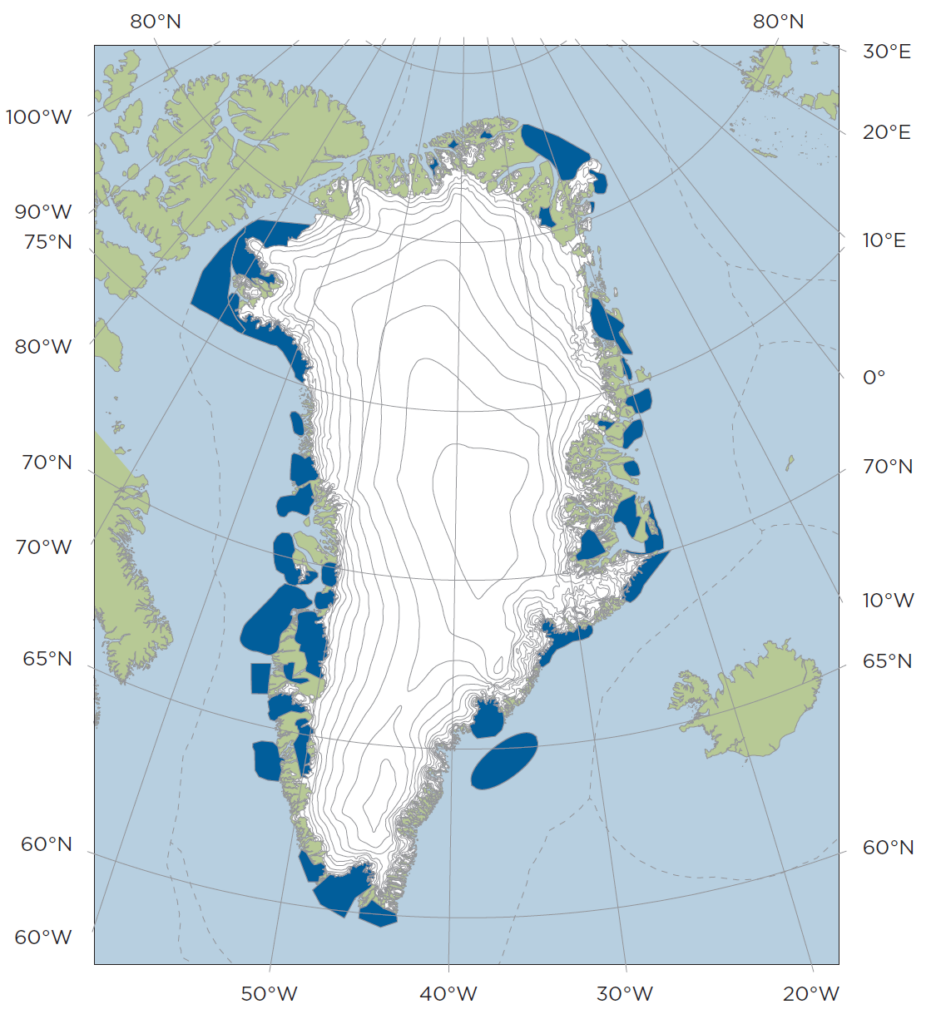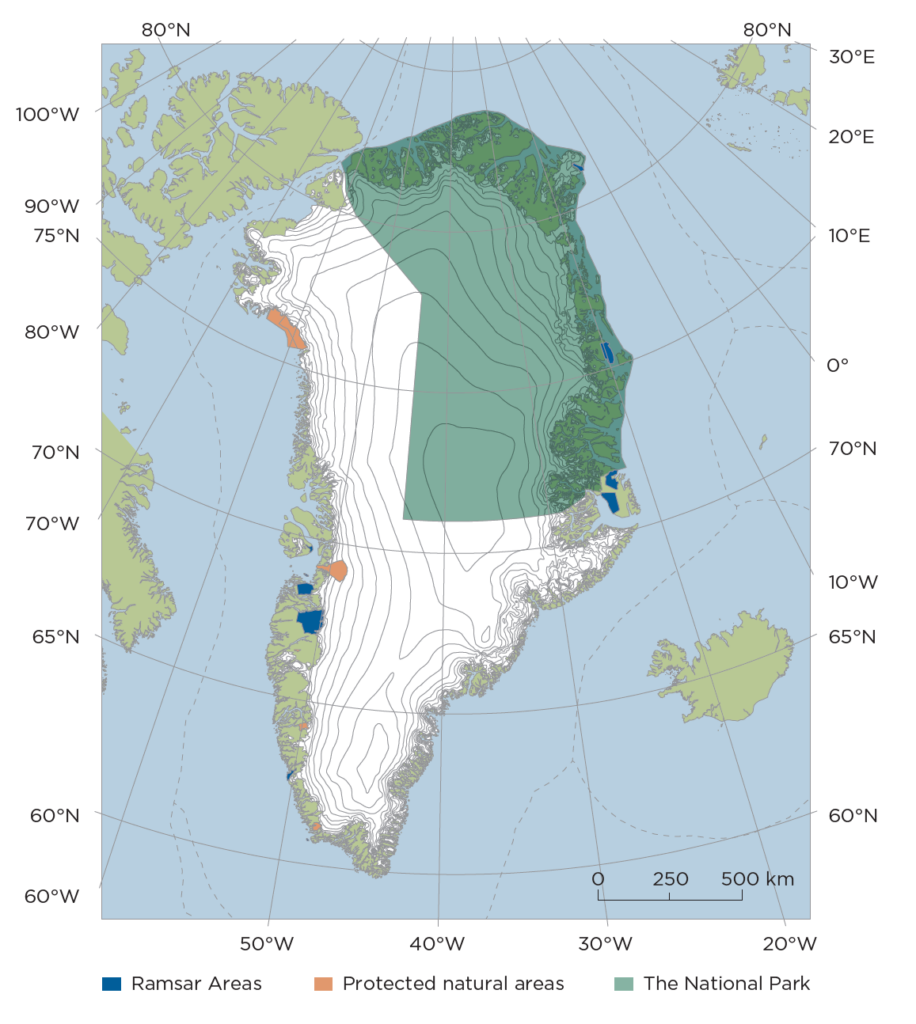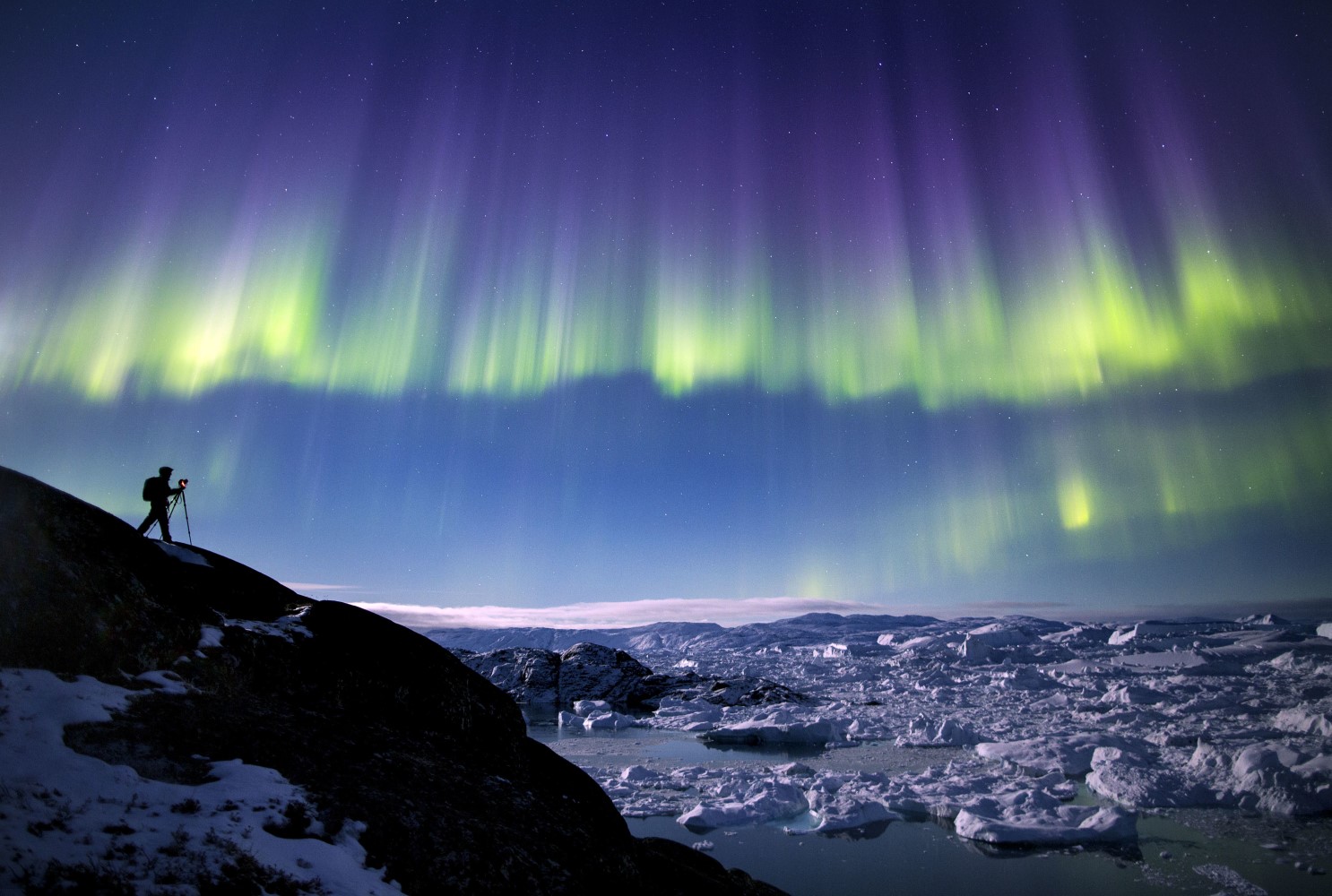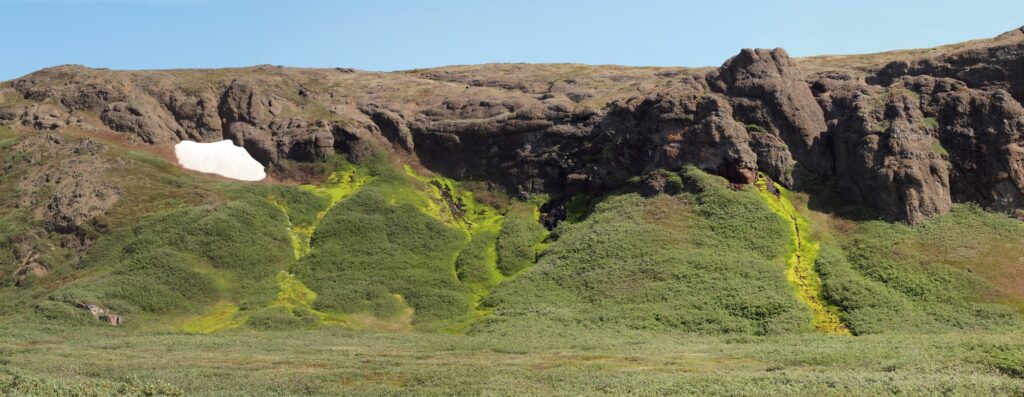
Biodiversity includes all living organisms on land, in freshwater, in the sea, on glaciers and in the air. The species that live on Greenland have adapted to the extreme living conditions of the Arctic climate with low temperatures, prolonged snow and ice cover and periods with no or permanent sunlight. However, living conditions vary significantly from north to south, from the deep sea to the coast and from the coast to the ice sheet. Within these gradients, life conditions are also controlled by ocean currents, salinity, nutrient conditions, geological conditions, permafrost, glacier dynamics, snow and ice conditions, temperature, etc. These conditions also determine primary production, and subsequently the food availability in the Arctic ecosystems.
Greenland is the contiguous land area of the Arctic, which has the longest north-south stretch (more than 2,600 km). Greenland’s land area spans across several climate zones and, by using climatic criteria, it is divided into High Arctic, Low Arctic and Sub-Arctic ecosystems, which in turn can be divided into floristic provinces based on differences in vegetation. Individual adaptation and dispersal possibilities mean that species are distributed differently. Some species are widespread throughout the country, some are associated with certain habitat types, while others are only known from a few localities.

MARTIN BLICHER, 2020
The marine biodiversity
Greenland’s marine biodiversity is contingent on the water circulation and ocean currents that characterise the entire North Atlantic and the Arctic sea areas. The North Atlantic Ocean Current is an extension of the Gulf Stream and is relatively warm and saline. This current mixes with the cold and relatively fresh water from the Arctic Ocean and, closer to the coast, with the fresh water supply from rivers, glaciers and the ice sheet. Sea ice, nutrient availability and seasonal variations in physical conditions play a major role in the productivity of marine ecosystems.
On the basis of these complex physical and biological conditions, Greenland’s marine areas can be divided into larger and smaller marine ecosystems. In particular, the coastal areas can be divided into small area types based on more detailed knowledge of physical conditions (e.g. banks, polynyas, fjords and the coast), productive conditions (e.g. primary production of algae and zooplankton) and important areas for sustaining life in the sea (e.g. foraging areas, spawning grounds and rearing areas).
Arctic species
The biodiversity of the Arctic, including Greenland, generally includes fewer species compared to temperate and tropical areas, but many of the Arctic species are unique in how they adapt to the extreme climate conditions that prevail in the Arctic.
Many of the species that occur in Greenland are also widespread in other regions of the Arctic. However, there are also species found only in Greenland (endemic species), as well as species where much of the world’s total population lives in Greenland (national responsibility species). Naalakkersuisut (Government of Greenland) regularly updates a list of endangered species in Greenland, a socalled Red List, where the main focus is on endemic species and national responsibility species.
Through the Greenlandic Nature Protection Act and international treaties, Greenland has a special obligation to protect the country’s biodiversity, which is why there is a special management focus on these red list species.
Nature has always been the foundation for the survival of humans in the Arctic climate, and it still plays a major role for the economy, culture, health and well-being. Our use of nature can have an adverse effect on species and ecosystems. This may be through unsustainable fishing and hunting, or through changes in habitats (e.g. bottom trawl, agriculture, mining and the establishment of infrastructure), pollution (from local sources and long-range transboundary pollution), introduction of invasive species, noise from transport or other forms of disturbance.
Climate change and biodiversity

NATUREMAP.EAMRA.GL
Biodiversity is also affected by climate change. Already today, there are signs of changing dispersion patterns, lusher vegetation and ‘ecological mismatch’ – a temporal shift in the growth of plants so that it does not match caribou calving and the emergence of insects, for example.
With higher temperatures, southern species can spread to and establish themselves in Greenland, either naturally or with the help of humans, and potentially pose a threat to the species that already exist here today. The High Arctic ecosystem to the north is particularly vulnerable to climate change. Some species are expected to be able to adapt to minor changes in the climate, while others will be challenged by limited dispersal options to the north. In the long run, climate change might therefore pose a threat to the High Arctic ecosystem.
The mapping of Greenland’s biodiversity is being challenged by the size of Greenland and the financial resources available for such studies. In this context and what is especially important is the knowledge about the distribution of species (e.g. habitats, important breeding, foraging, rearing, shedding/moulting and hibernation areas), species’ vulnerability to disturbances and climate change (e.g. endangered species) and knowledge of particularly unique habitat types (e.g. areas with high primary production, hot springs and salt lakes).
Whereas relatively good data is available about most exploited animal species, knowledge of other groups of species is more sporadic. Researchers have mapped the areas that are considered valuable in relation to protecting Greenland’s biodiversity.
Nature management
Nature in Greenland is affected by climate change and various forms of human disturbance. To protect Greenland’s biodiversity, the Naalakkersuisut has therefore implemented laws and executive orders that regulate the exploitation and protection of Greenland’s nature.
Nature protection in Greenland is generally managed according to Greenland Parliament Act no. 29 of 18 December 2003 on nature protection (the Greenlandic Nature Protection Act), but a number of other laws also relate directly to nature management in Greenland. Today, the management of Greenland’s biodiversity is divided between several ministries that attend to nature and environmental protection in relation to conservation efforts and in connection with the exploitation of living resources, mineral resources and genetic resources.
Protection of natural areas
Nature in Greenland is managed through the protection of natural areas and species, regulation of the exploitation of living resources as well as regulation of activities that have a negative impact on nature. The protection of natural areas includes; protected areas designated by conservation orders, preservation of certain sites important for certain species (bird protection areas, seabird colonies, walrus landing sites, polar bear hibernation areas and areas closed to fishing or use of fishing methods that damage the seabed), protection of certain habitats and species no matter where they occur (hot springs, salt lakes, protected species), areas with restrictions related to mineral resource activities as well as protection lines along coasts, rivers, hot springs and salt lakes.
Exploitation of natural resources
The exploitation of the living resources (e.g. shellfish, fish, birds and mammals) is regulated by Greenland Parliament Act no. 18 of 31 October 1996 on fishing (as amended) and Greenland Parliament Act no. 12 of 29 October 1999 on catching and hunting (as amended), while the exploitation of genetic resources is regulated by Greenland Parliament Act no. 3 of 3 June 2016 on the exploitation of genetic resources and related activities. Underlying executive orders enable authorities to stipulate limitations on and conditions for exploitation, e.g. in the form of quotas and hunting seasons.
Foreign activities create pollution
Greenland’s nature is also directly or indirectly affected by activities in other countries. Global emissions of greenhouse gases and other pollution affect Greenland’s ecosystems and species. Pollution can reach Greenland by air or by sea currents and can be concentrated via the food chain. This means that some long-range atmospherically transported heavy metals end up in some of the species eaten in Greenland, including substances that are known to harm human health and learning ability (including mercury and cadmium).
Sustainable exploitation
Greenland also shares many exploited populations with other countries, such as some species of fish, marine mammals and birds. Sustainable exploitation of these populations therefore requires that the overall exploitation is sustainable across the countries that exploit the individual populations. This is one of the reasons why Greenland engages actively in international cooperation in the field of nature and the environment, including in the Convention on Biological Diversity, in the Arctic Council’s work groups as well as in international, multilateral and bilateral agreements and co-operation within fisheries and hunting, e.g. the International whale hunting Commission and fisheries organisations.
Preserved and protected areas

PAUL ZIZKA PHOTOGRAPHY/CATERS/RITZAU SCANPIX, 2016
The Greenlandic Nature Protection Act provides the framework for the designation of conservation areas in Greenland by giving authority to prepare conservation executive orders. Up to 2021, 12 national conservation areas have been implemented. Furthermore, in pursuance of the Greenlandic Nature Protection Act, 12 wetlands of international importance (Ramsar Areas) have been designated, some of which overlap with the 12 national conservation areas. These areas together represent 1,002,514 km² (about 41.6 % of Greenland’s land area incl. the ice sheet and 4.2 % of the sea area). The National Park in North and East Greenland alone represents 970.579 km² (including both land and sea areas).
Based on criteria defined by international organisations and conventions, some of the protected areas also have a special international status. Kangia (Ilulissat Icefjord) has been designated as a UNESCO World Heritage Site due to the area’s outstanding character with the fast-moving glacial current from the ice sheet with calving glaciers in the fjord and the stranding of colossal icebergs at the mouth of the fjord. Under the auspices of the Ramsar Convention, 12 Ramsar areas were designated in 2016. The National Park in North and East Greenland (established in 1974) was designated as a UNESCO Biosphere Reserve from 1977‑2018, after which its international status was deregistered due to changes in designation criteria, which Greenland did not believe the area could live up to.
Subject to other legislation, areas have been designated that also aim to protect nature, biodiversity or certain species from exploitation or destruction of habitats. These include areas with bans on certain types of fishing, 40 bird protection areas (2019), as well as protection of bird colonies, walrus landing sites and polar bear hibernation areas. In addition, there is the protection of important areas for vulnerable species in relation to the exploitation of mineral resources as well as protection zones to protect the coast, rivers, salt lakes and hot springs against development, overexploitation and other destruction.
Through municipal statutes, the Greenland municipalities can impose restrictions on traffic, resource exploitation, development, etc. in specified areas. In addition, informal agreements can be made locally between fishermen/hunters to regulate exploitation in certain areas.
Further reading
- Agriculture in Greenland
- Bird species in Greenland
- Coasts
- Geology in Greenland
- Greenland shark
- Horticulture
- Industry and labour market
- Release of the musk oxen
- Seals in the Greenlandic waters
- Seasonal pollution in Northeast Greenland
- Systematic environmental monitoring
- The climate in Greenland
- The fresh waters
- The ice sheet
- The ice-free landscapes
- The National Park in north and east Greenland
- The polar bear
- The sea and the fjords
- Towns and settlements
- Tree planting in Greenland
- Whale species and whaling
- World heritage: Aasivissuit – Nipisat
Read more about Nature and Landscape in Greenland

